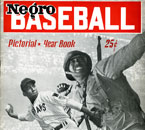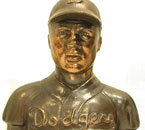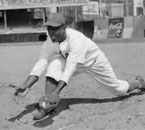Throughout the 1950s and 1960s, as professional sports became more integrated, images of African American athletes entered the culture at large through newspapers, picture magazines, newsreels, movies, television, and sports memorabilia, such as baseball cards, clothing, and toys.
The mainstream media, concerned with the racial anxieties of white readers, typically portrayed black athletes as apolitical and unthreatening—their decency and gentleness away from the field emphasized. It perpetuated an unthreatening and uncomplicated view of black sports figures—wresting them from the reality of prejudice, its continued effect on their lives, and their own reactions to it.
Overall, black periodicals enthusiastically followed the careers and personal lives of African American athletes, earlier and with far greater frequency than mainstream publications. Athletes’ stories were routinely tied to the broader matters of racial prejudice and segregation in American life, and their successes were interpreted as a measure of racial progress.
The modest acknowledgment of black achievement in the mainstream media nevertheless served a useful, if qualified, purpose in the struggle for civil rights. Positive depictions of sports figures inspired racial pride in a people long subjected to negative images of themselves in the mainstream press, and appealed to white Americans to abide by the doctrines of fair play and sportsmanship.
Image Credits/Captions (Click on thumbnails for full image)
Negro Baseball Pictorial Yearbook, 1945. 10 15/16 x 8 5/8 in. Collection of Civil Rights Archive/CADVC-UMBC, Baltimore, MD, 2009.1. For more than seventy-five years, black players were banned from major league baseball. In response to this unwritten policy, the Negro leagues were formed in the late nineteenth century, a collection of professional baseball associations made up of predominantly African-American teams. The Negro leagues issued posters and handbills for distribution to black audiences. Its players were routinely covered in African-American periodicals, but remained invisible in the mainstream media.
Bank, c. 1950. Cast metal with bronze plating. 6 1/8 x 5 3/16 x 3 7/8 in. Collection of Civil Rights Archive/CADVC-UMBC, Baltimore, MD, 2005.198. By 1952, there were 150 African-American players in professional baseball, the best of the Negro Leagues having migrated to the integrated minors and majors. Black baseball heroes were now able to assume their rightful place alongside their white contemporaries in mid-twentieth-century mainstream visual culture, including baseball cards, banks, toys, and other memorabilia.
Jackie Robinson’s First Game in the Major Leagues, Boston at Brooklyn, Ebbets Field, April 15, 1947. Watch: http://www.usatoday.com/sports/baseball/2007-04-13-robinson-footage_N.htm?POE=click-refer


